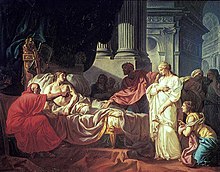Erasistratos
Erasistratos (* around 305 BC in Iulis , today the old town of Ioulis, on Keos ; † around 250 BC ) was a Greek doctor and naturalist, anatomist , surgeon and physiologist . Along with Herophilos of Chalcedon and Eudemus of Alexandria, he is considered to be the main representative of the Alexandrian school and together with him and Galenus as the most important descriptive anatomist of antiquity .
Life
His exact life dates are not known. Erasistratos was born in Iulis on the Aegean island of Keos (today Kea) as the son of Cleombrotus, the personal physician of the Diadoch prince Seleukos I , and the Kretoxene. In addition to his father and his uncle Medios, his brother Cleophantos was also a doctor. He studied medicine in Athens , where Metrodorus , a son-in-law of Aristotle , is said to have been his teacher. Around 280 BC He went to Kos , the birth island of Hippocrates , and continued his anatomical and surgical studies with Praxagoras . Finally he settled in Alexandria , where the early Ptolemies (Ptolemy I and Ptolemy II) were in a very science-friendly mood. There he was able to carry out extensive sections on people. He also dissected animals. It is controversial whether he actually, as he was later accused, dissected live criminals sentenced to death ( vivisection ).
plant
Erasistratos mainly examined the nervous and circulatory systems . As already recognized by Herophilos , his findings include the distinction between sensory and motor nerves , and contrary to the prevailing opinion, he did not consider these to be hollow, but rather as containing spiritus animalis and connected to the brain as the seat of sensations . He also provided very precise descriptions of the anatomy of the brain with a distinction between the cerebrum and cerebellum and descriptions of the cerebral convolutions ( gyri ) and recognized that all nerves ultimately come from the brain. His accurate neurophysiological observations, such as the role of the cerebellum in coordination of movements, suggest that he actually performed vivisections, at least on animals. Furthermore, he distinguished the small (lung) from the large (body) circulation and described the heart valves , the trachea and the pancreas .
Only fragments of the records of Erasistratos have survived due to the citations of Galen, Oreibasios and other authors; the originals were probably irretrievably lost in the first (48 BC) or second (391) fire in the library of Alexandria .
A school of the Erasistrateer existed in Rome until the 2nd century AD.
Legend
A legend handed down to us by Appian and Plutarch tells that Antiochus , the son of the Syrian king Seleucus I Nicator , was seriously ill and that his father, after all the other doctors had no advice, called Erasistratus. When he was examining Antiochus, the king's young wife, Stratonike I , entered the room and Erasistratus recognized (after he had also let all the other ladies-in-waiting pass by one after the other), from the accelerated pulse of his patient, that it was not physical suffering but love for unattainable stepmother of the illness was the basis and he brought with it the king Seleucus to give Stratonike the prince Antiochus to wife. Even though Erasistratos could not have been the Seleucid personal physician at that time (Antiochus married Stratonike in 293 BC), this illustrates his place in the ancient history of medicine. A variant of this anecdote is also found in the Four Treatises of Niẓāmī ʿArūḍī (around 1100/1160), in which Avicenna (980-1037), the author of the canon of medicine , appears as a doctor.
swell
- Heinz Schott (Ed.): Milestones in Medicine. Harenberg, Dortmund 1996. ISBN 3-611-00536-3 .
- Article in Enkephalos . in: Archives of Neurology and Psychiatry
- Markwart Michler †: Erasitratos. In: Werner E. Gerabek , Bernhard D. Haage, Gundolf Keil , Wolfgang Wegner (eds.): Enzyklopädie Medizingeschichte. De Gruyter, Berlin / New York 2005, ISBN 3-11-015714-4 , pp. 363-366.
Individual evidence
- ↑ Jutta Kollesch , Diethard Nickel : Ancient healing art. Selected texts from the medical writings of the Greeks and Romans. Philipp Reclam jun., Leipzig 1979 (= Reclams Universal Library. Volume 771); 6th edition ibid 1989, ISBN 3-379-00411-1 , p. 28.
- ↑ Urs Boschung : Sensibility. In: Werner E. Gerabek , Bernhard D. Haage, Gundolf Keil , Wolfgang Wegner (eds.): Enzyklopädie Medizingeschichte. De Gruyter, Berlin / New York 2005, ISBN 3-11-015714-4 , p. 1321.
- ↑ Ivan Garofalo (ed.): Erasistrato, I frammenti. Pisa 1988.
- ^ Karl-Heinz Leven : Erasistratos , in: Wolfgang U. Eckart and Christoph Gradmann (eds.): Ärztelexikon. From antiquity to the 20th century , 1st edition CH Beck Munich 1995, 2nd edition Springer Heidelberg, Berlin et.al 2001, 3rd edition Springer Heidelberg, Berlin et.al. 2006, pp. 108 + 109, print and online version ( ISBN 978-3-540-29584-6 or ISBN 978-3-540-29585-3 ).
- ↑ Appian , Syriake 59-61; Plutarch , Demetrius 38.
- ^ Gotthard Strohmaier : Avicenna. Beck, Munich 1999, ISBN 3-406-41946-1 , p. 122 f.
| personal data | |
|---|---|
| SURNAME | Erasistratos |
| ALTERNATIVE NAMES | Erasistratos of Chios |
| BRIEF DESCRIPTION | Greek doctor |
| DATE OF BIRTH | around 305 BC Chr. |
| PLACE OF BIRTH | Iulis on Chios |
| DATE OF DEATH | around 250 BC Chr. |
